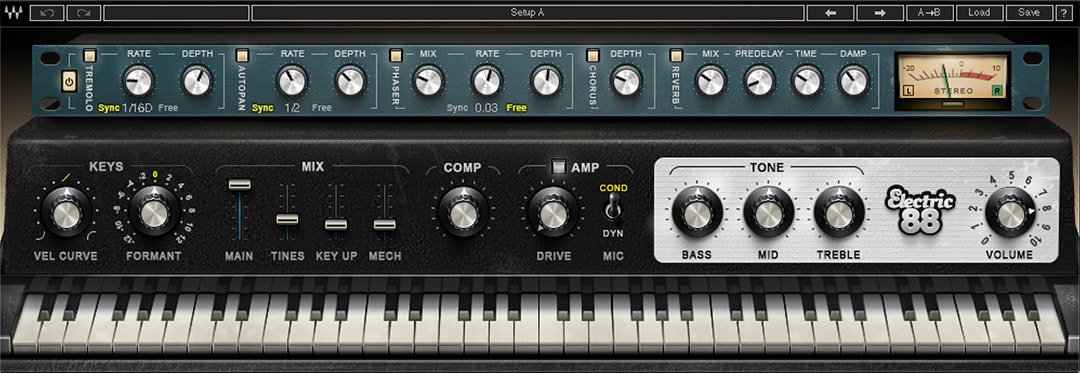As a keyboardist with a lifelong love-affair with the Rhodes electric piano, I’m always intrigued by new virtual instruments simulating that classic sound. The one I use most of the time I bought many years ago from a developer called Scarbee, and I have been pretty happy with it. (Scarbee products have been subsumed into the Native Instruments product line, and I assume those samples are still part of the “Komplete” collection.) When Waves came out with their version at an introductory price of $39, I decided to take a risk and order it.
The Samples
In their promo material, Waves explains that they wanted to capture the raw essence of a real Rhodes. In some ways, they did, and this is the beginning of my issues. What I really think they did was sample an ill-maintained, inconsistent instrument. As an example, D5 (C4=middle C) sounds appropriately punchy but a half-step up, Eb5 is anemic and muddy, at the same velocity, and has no punch no matter how you play. Continuing to E5, the punch returns. This makes playing evenly very difficult. My assumption is that in trying to be “real” they left it this way. If this were my Rhodes, I would have adjusted the tine and pickup to fix this (It most certainly can be done; I have voiced many of these instruments.) There are many other examples of inconsistent tone across the keyboard. In my opinion, these “warts” are too exaggerated and would be frustrating on a real instrument, let alone a sampled version. Overall, the tone is nice, but the decay seems pretty short, less singing and more mallet-like overall. It is not possible to determine how many velocity samples there are, nor can I detect any rotation of alternate samples on the same key. In general, there is not a lot tonal change from quiet to loud, and the classic distorted “bark” on loud notes is not really possible to achieve.
There are four layers available, beyond the basic sample (called “main”) including “tines” “key up” and “mech.” The “tines” layer is not what you expect, but rather what sounds like some kind of alternate sample, perhaps with a microphone or other pickup. While interesting, it sounds nothing like Rhodes tines, and includes a fundamental pitch up an octave from the main note, creating a kalimba-like mallet sound. This octave-up component of these samples makes them detract from the normal tone, because it changes the basic harmonic content in a strange way. Layering it with the natural samples creates an interesting synthetic sounding hybrid, but not realistic.
“Key up” is a useful layer, adding the buzz that occurs when the dampers mute the tines, and a bit of this adds to the natural quality. Generally, a level of about 40% on this fader would be enough, and the rest of the fader travel beyond that point is too loud to be realistic.
Finally there is “Mech,” which sounds like the harp sampled with a microphone, capturing the mechanical noises of the tines and the action. This is a nice addition, though when playing a real Rhodes through any kind of amp, these sounds are not really heard; as a matter of fact, to hear them, you would need to take the lid off the instrument. Definitely an interesting layer for experimentation. Once again, there is a strong second harmonic (octave) component that doesn’t sound typical to me of a lid-off tone, and some notes oddly are all thump while others are more pitched, even when they are adjacent. I can detect vary little if any dynamics in this layer, other than volume changes.
Control and Velocity
To the left of the layer faders are two knobs. The first one for velocity scaling, which allows concave, linear and convex velocity curves. This is well-implemented, allowing quick changes to customize the response. That said, the dynamic range of this instrument seems very narrow, especially in the “tines” layer. There is no way to control how wide the variation is, only how the middle of the range is handled.
The “formant” knob timbre-shifts the samples up or down. What this means is that when turned to the right, samples from lower down are pitch-shifted upward. Lower pitched samples generally have more harmonics, so the result is subjectively brighter. Likewise, shifting to the left, higher samples are pitch-shifted down, creating a darker, more percussive sound. As a special effect, this is a quick way of getting a different sound, but in terms of realism it is subjectively synthetic. Once again, a good addition, mostly for creating experimental sounds. Keep in mind that only “main” and “key up” are shifted by this control, not “tines” or “mech.” It would have been more interesting to allow those to be shifted as well, in my opinion, especially “tines” which is already a synthetic-sounding layer. One other observation about “formant” is that any inconsistencies in the sound shift up and down with this knob, meaning the dead notes and loud notes are in new places when you change this parameter.
Tone Controls
Moving to the right, there is a “comp” knob. The manual describes it as blending between compressed and uncompressed sounds. Try as I may, I can’t get this to behave like any compressor I have ever used; the sound jumps in volume at about 11:00 and then seems to stabilize. Typically a compressor would be used to control attacks, or to bring up the decay creating a different dynamic curve to each note. I can hear none of this happening here. This confounds me, since Waves is arguably a world-leader in software compressors.
The “amp” section includes a “drive” control and a selection switch between dynamic and condenser microphones. The drive control is very smooth, and allows a bit of growl in the tone. You won’t get any “Hymn of the 7th Galaxy” hard distortion here, however. The cabinet simulator is pleasant, though you get no choice of speaker type, nor is there any room-tone in the amp sound. (not a problem for me, I prefer to add that ambience myself. )
Bass, mid and treble controls round out the front panel. Sadly, these look like the passive controls on a Rhodes, or on a Fender amplifier, but have much more of a resonant, active sound than I prefer. The bass control seems a bit too high, perhaps 150-200hz, and the treble seems more like an upper-midrange, like 2-4khz. Somehow they missed the crucial “body” and “tines” frequencies I need with this setup. I think that Waves should have either gone with a gentle shelving control like the original, or gone “all the way” with the parametric EQ and given us frequency and bandwidth controls. As it stands, this EQ is squawky and resonant, and there is no way to change it.
*Update: upon re-reading the manual, it states that the treble control is shelving at 1875hz, corroborating what I heard. I think that is too low. The mid control is peaking at 900hz, and the bass is low shelf at 203(?) hz. To me, 203 is a bit high for “bass,” at least as the only control.
Effects
There is a virtual rack above the piano controls, covering the typical stomp-box-style effects one would apply to an electric piano, with an overall on-off control as well as individual effect bypass buttons.
First, there is “tremolo,” set up nicely with tempo-synced options left-of center and free-run to the right. A mono tremolo is more associated with the Wurlitzer, but it is good to have that option.
“Auto-pan” is next, with the same sync options. This is well-done, and creates the “bumpy” stereo panning of a real suitcase Rhodes.
“Phaser” is a stand-out in the effects. With the mix, speed and depth, you can create most of the classic phase-shifter sounds, from Zawinul’s swirly “A Remark You Made” to the subtle “Hey Nineteen” sound. As an effect-maker, Waves clearly brought their circuit-modeling expertise to this module.
On the other hand, “chorus” is a disappointment, mostly because it only has one knob. I’m guessing they needed the space on the panel, but the lack of a speed control cripples this otherwise nice-sounding effect. I often use ultra-slow rates to create subtle effects, or fast rates for Leslie-like bubbling sounds. Neither of these tones are available in this effect.
As expected from Waves, “reverb” is glorious. Rich and smooth, easy to set and with lots of range. I would love to be able to use this reverb on other sounds. The inclusion of pre-delay was nice, but truthfully, a chorus-rate control would have been better use of the front-panel space.
The omission of a delay of any kind is surprising, since many players (including me) use a subtle stereo delay to add motion to the parts. Chick Corea usually has these on his Rhodes, and it adds a lot of space to the sound. In my opinion, the mono tremolo could have been ditched in favor of this, with a mono switch on the auto-pan to make this available. Nobody is likely to use both tremolo and auto-pan together, so this would have been a more compact solution.
Processor and Latency
For me, the main purpose of this VI is for live playing, or for live-in-the-studio tracking, where latency is of the utmost importance. Upon launching the stand-alone, you are given options for MIDI and Audio routing, as well as buffer size. I have found that at buffer sizes of more than 128, delay becomes noticeable to me as a keyboard player; so it is with this instrument as well. There are no glitches at 128, and at that setting it tracks like a hardware keyboard.
Processor load is another issue, however. At any buffer setting, Electric 88 uses more than 50% of my processor cycles. (I use a Macbook Pro 17-inch dual-core i5 at 2.53ghz.) This was the processor load with no notes being played. As soon as I began to actually hit the keys, the load went up instantly to 70-90%. This is a LOT of processor cycles. I did some experiments to see if this could be managed: Raising the buffer to 512, which makes the latency quite noticeable, makes no difference in processor load. Nor does turning off the effects. Also, turning off unused layers, such as “mech” or “tines” clearly only mutes them, but does not free up any resources. The instrument uses a reasonable 524MB of ram, though that seems a like a lot in our day of direct-from-disk sample streaming.
I was unable to evaluate Electric 88 in the environment of my DAW, MOTU Digital Performer 9, because the plug-in failed the Audio Units evaluation during start-up. It’s not easy to know if this is a Waves issue or a MOTU issue. I can say this failure is rare when I install new AU plug-ins.
Conclusion
Waves Electric 88 has a nice user interface and lovely effects, but the general sound keeps it from being my go-to electric piano sound, due to the tonal inconsistency, limited dynamics and tonal problems. My feeling is that Waves has a way to go in the sampled-instrument area, compared to their leadership in processors and effects. It is probably worth it at $39 as an alternative sound, but for the full price I would feel a bit let down.


